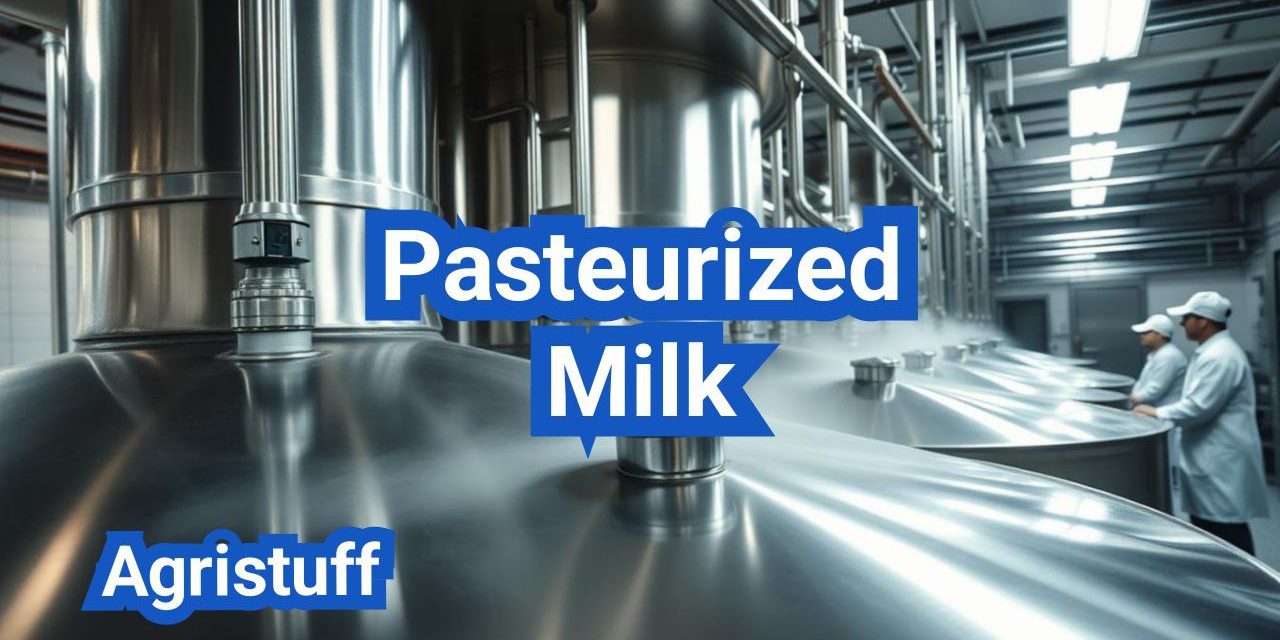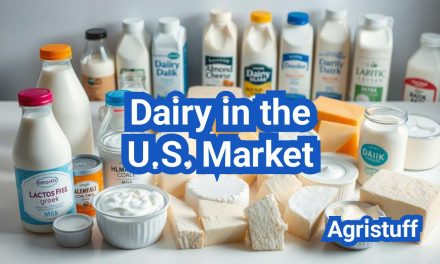The process of pasteurization is crucial in making milk safe for consumption. By applying a certain amount of heat for a set period, harmful bacteria in raw milk are killed, significantly reducing the risk of milk-borne illnesses.
This milk pasteurization process has been a cornerstone in public health, ensuring that the milk consumed is free from pathogens. The importance of pasteurized milk cannot be overstated, as it plays a vital role in safeguarding consumer health.
Key Takeaways
- Pasteurization is essential for killing harmful bacteria in milk.
- The process involves applying heat for a specific duration.
- Pasteurized milk is crucial for public health safety.
- The pasteurization process significantly reduces milk-borne illnesses.
- Consuming pasteurized milk safeguards consumer health.
Understanding Pasteurized Milk
The concept of pasteurized milk is rooted in the work of Louis Pasteur, a scientist whose discoveries revolutionized food safety. Pasteurized milk is milk that has been treated with heat to kill harmful bacteria and extend its shelf life.
Definition and Basic Concept
Pasteurized milk is defined by the process it undergoes, which involves heating the milk to a high temperature for a specified period, followed by rapid cooling. This process, known as pasteurization, was first developed by Louis Pasteur in the 19th century.
The basic concept behind pasteurization is to eliminate pathogenic microorganisms that can cause disease, thereby making milk safer for consumption. The pasteurization process has become a critical step in dairy production, ensuring that milk is safe for drinking.
Historical Development by Louis Pasteur
Louis Pasteur’s work on pasteurization began as a response to the spoilage of wine and beer. He discovered that by applying heat to these liquids, he could prevent unwanted fermentation. This principle was later applied to milk, revolutionizing dairy production.
Pasteur’s development of pasteurization not only saved the wine industry but also paved the way for safer milk consumption. His work laid the foundation for modern dairy safety standards.
Why Milk Requires Pasteurization
Raw milk can harbor dangerous bacteria such as Salmonella, E. coli, and Listeria, which can pose serious health risks to consumers, especially the elderly, pregnant women, and young children.
Pasteurization is crucial because it significantly reduces the risk of milk-borne illnesses. By killing harmful pathogens, pasteurization ensures that milk is safe to drink and consumes. The importance of pasteurization cannot be overstated, as it has been instrumental in preventing outbreaks of milk-related illnesses.
The Science Behind Milk Pasteurization

The science behind milk pasteurization involves applying heat treatment to raw milk to kill pathogens. This process is crucial for ensuring the safety of milk for consumption.
How Heat Treatment Eliminates Harmful Bacteria
Heat treatment is the cornerstone of milk pasteurization. By applying heat for a specified period, pasteurization effectively eliminates harmful bacteria such as Campylobacter, E. coli, and Salmonella that may be present in raw milk. The heat denatures proteins in these bacteria, disrupting their cellular processes and ultimately leading to their death.
The effectiveness of heat treatment depends on two key factors: temperature and duration. Higher temperatures can kill bacteria more quickly, but there’s a limit to how high the temperature can be without affecting the milk’s quality. Thus, pasteurization protocols are carefully designed to balance these factors.
Specific Pathogens Targeted in Milk
Several pathogens are commonly associated with raw milk, including:
- Campylobacter: A leading cause of gastroenteritis, often linked to raw milk consumption.
- E. coli: Certain strains can cause severe foodborne illness, making their elimination critical.
- Salmonella: A common pathogen that can be present in raw milk, posing a significant health risk.
- Listeria monocytogenes: Can cause listeriosis, particularly in vulnerable populations like the elderly and pregnant women.
These pathogens are effectively controlled through pasteurization, significantly reducing the risk of milk-borne illnesses.
Biological Principles of Heat Inactivation
The biological principle behind heat inactivation lies in the denaturation of proteins and disruption of cell membranes. When bacteria are exposed to heat, their proteins unfold and lose function, and their cell membranes become compromised. This ultimately leads to the death of the bacterial cells.
The thermal death time (TDT) curve illustrates the relationship between temperature and the time required to kill a specific bacterial population. Understanding this principle is crucial for designing effective pasteurization protocols.
By applying the science behind milk pasteurization, dairy processors can ensure that milk is safe for consumption while maintaining its nutritional value and quality.
The Complete Pasteurized Milk Processing Journey
Raw milk collection is the first step in a complex process that ultimately results in the pasteurized milk available to consumers. This journey involves several critical stages that ensure the milk is safe, nutritious, and of high quality.
Raw Milk Collection and Transport
The process begins with the collection of raw milk from dairy farms. Raw milk is typically collected in refrigerated tankers to maintain its quality during transportation to the processing plant. The tankers are equipped with cooling systems to keep the milk at a low temperature, usually around 4°C (39°F), to slow down bacterial growth.
Key considerations during raw milk collection include:
- Maintaining cleanliness and hygiene during milking and storage
- Cooling the milk to the appropriate temperature promptly
- Monitoring the milk for any signs of spoilage or contamination
Initial Testing and Quality Control
Upon arrival at the processing plant, the raw milk undergoes initial testing and quality control checks. These tests are crucial for ensuring that the milk meets the required standards for pasteurization.
Tests typically include:
- Bacterial count
- Somatic cell count
- Antibiotic residue testing
- Temperature checks
Pre-Pasteurization Preparation
Before pasteurization, the raw milk is prepared through various processes, including standardization of fat content, addition of vitamins, and removal of any contaminants. This step is essential for achieving the desired nutritional profile and consistency of the final product.
The preparation may involve:
- Standardizing the fat content to the desired level
- Fortifying the milk with vitamins D and A
- Removing any bacteria or other pathogens
Post-Processing Handling
After pasteurization, the milk is packaged in sterile containers and stored in refrigerated conditions to maintain its quality. Proper handling practices during this stage are critical to prevent contamination and ensure the milk remains safe for consumption until it reaches the consumer.
Key aspects of post-processing handling include:
- Maintaining the milk at a consistent refrigerated temperature
- Ensuring packaging is sealed properly to prevent contamination
- Monitoring the milk for any signs of spoilage during storage and distribution
Standard Pasteurization Methods and Temperatures

Effective pasteurization is key to maintaining the quality and safety of milk products. Pasteurization involves heating milk to a specific temperature for a certain duration to eliminate harmful bacteria without significantly affecting the milk’s nutritional value or taste.
HTST Pasteurization (161°F for 15 seconds)
High-Temperature Short-Time (HTST) pasteurization is a widely used method that involves heating milk to 161°F (72°C) for at least 15 seconds. This method is efficient and effective in killing pathogens while preserving the milk’s quality. HTST pasteurization is continuous, making it suitable for large-scale dairy operations.
Vat/Batch Pasteurization (145°F for 30 minutes)
Vat or batch pasteurization involves heating milk to 145°F (63°C) for 30 minutes. This method is often used for smaller batches or in specialty dairy productions. It allows for a more traditional approach to pasteurization and can be beneficial for certain types of milk products.
The vat pasteurization process requires careful monitoring to ensure that the temperature is maintained consistently throughout the holding period. This method is typically used in conjunction with agitation to ensure uniform heating.
Temperature Monitoring and Control Systems
Temperature monitoring and control systems are crucial in both HTST and vat/batch pasteurization methods. These systems ensure that the milk is heated to the correct temperature and held for the required duration, thereby ensuring the elimination of harmful pathogens.
Modern pasteurization equipment is equipped with sophisticated temperature control systems that can accurately monitor and adjust the temperature in real-time. This not only ensures compliance with safety regulations but also helps in maintaining the quality of the milk.
By employing advanced temperature monitoring and control systems, dairy producers can achieve consistent pasteurization results, ensuring the production of safe and high-quality milk products.
Ultra-Pasteurization and UHT Processing Explained
To meet consumer demands for safer and longer-lasting dairy products, manufacturers use ultra-pasteurization and UHT processing. These advanced techniques have revolutionized the dairy industry by significantly extending the shelf life of milk products while maintaining their nutritional value.
Ultra-Pasteurized Milk Production
Ultra-pasteurized milk is produced by heating milk to a high temperature of 280°F (138°C) for a short duration of 2 seconds. This process effectively eliminates harmful bacteria, extending the shelf life of milk. The rapid heating and cooling process helps preserve the milk’s nutritional content and flavor.
UHT Shelf-Stable Milk Technology
UHT (Ultra High Temperature) processing involves heating milk to an even higher temperature range of 275-302°F (135-150°C) for a brief period, typically 2-5 seconds, followed by rapid cooling. This method produces shelf-stable milk that can be stored without refrigeration until opened. The UHT process is particularly useful for milk products distributed in areas with limited refrigeration.
- UHT processing allows for longer storage and transportation of milk products.
- The high heat treatment kills bacteria and other pathogens, ensuring the milk is safe to consume.
Comparing Standard Pasteurized Milk vs UHT
Standard pasteurized milk is heated to 161°F (72°C) for at least 15 seconds, whereas UHT milk is heated to a much higher temperature for a shorter duration. The key differences between standard pasteurized milk and UHT milk lie in their shelf life, storage requirements, and nutritional content.
| Characteristics | Standard Pasteurized Milk | UHT Milk |
|---|---|---|
| Shelf Life | 7-10 days refrigerated | Several months unrefrigerated |
| Storage | Requires refrigeration | No refrigeration needed until opened |
As noted by dairy processing experts, “UHT processing offers a convenient and safe solution for milk distribution in regions with limited cold chain infrastructure.” The choice between standard pasteurized milk and UHT milk depends on consumer preferences, distribution logistics, and storage capabilities.
“The development of UHT processing has been a game-changer for the dairy industry, enabling the global distribution of milk products with enhanced safety and longer shelf life.”
Dairy Processing Expert
Essential Equipment in a Pasteurized Milk Plant

The production of pasteurized milk relies heavily on specialized equipment to ensure the milk is safe for consumption. This equipment is crucial for achieving the high temperatures required for pasteurization and for maintaining the quality of the milk throughout the process.
Heat Exchangers and Pasteurization Units
Heat exchangers are a critical component in pasteurized milk plants, responsible for heating the milk to the required temperature and then cooling it down. There are different types of heat exchangers used, including plate heat exchangers and tubular heat exchangers. These units are designed to efficiently transfer heat, ensuring that the milk is pasteurized effectively without compromising its nutritional value.
Key Features of Heat Exchangers:
- Efficient heat transfer
- Compact design
- Easy to clean and maintain
Homogenizers and Separators
Homogenizers are used to ensure that the fat molecules in the milk are evenly distributed, preventing cream separation and improving the overall texture of the milk. Separators, on the other hand, are used to separate cream from skim milk. Both pieces of equipment are vital for producing high-quality pasteurized milk with consistent taste and texture.
Storage Tanks and Packaging Systems
Storage tanks are used to store pasteurized milk before packaging. These tanks are designed to maintain the quality of the milk by keeping it at the correct temperature. Packaging systems, including filling machines and capping machines, are used to package the milk in various formats such as bottles, cartons, or plastic jugs.
| Equipment | Function |
|---|---|
| Heat Exchangers | Heating and cooling milk |
| Homogenizers | Even distribution of fat molecules |
| Storage Tanks | Storing pasteurized milk |
| Packaging Systems | Packaging milk in various formats |
Cleaning and Sanitization Equipment
Cleaning and sanitization equipment are essential for maintaining hygiene standards in pasteurized milk plants. This equipment includes CIP (Clean-In-Place) systems, which are used to clean and sanitize the equipment and pipelines without disassembling them.
Benefits of CIP Systems:
- Reduced downtime
- Improved hygiene
- Increased efficiency
Setting Up a Pasteurized Milk Plant

A pasteurized milk plant is a sophisticated facility that demands considerable investment in equipment and regulatory compliance. The process of establishing such a plant involves various costs, including equipment, labor, and regulatory expenses.
Initial Investment Requirements
The initial investment for a pasteurized milk plant includes costs associated with land acquisition, construction, equipment, and initial operational expenses. The total cost can vary widely depending on the size of the plant and the technology used.
Key components of initial investment:
- Land acquisition and preparation
- Construction of the plant
- Purchase and installation of equipment
- Initial inventory and supplies
Pasteurized Milk Plant Cost Breakdown
The cost of setting up a pasteurized milk plant can be broken down into several categories. The major expenses include equipment costs, construction costs, and regulatory compliance expenses.
| Cost Category | Estimated Cost |
|---|---|
| Equipment Costs | $500,000 – $1,000,000 |
| Construction Costs | $1,000,000 – $2,000,000 |
| Regulatory Compliance | $100,000 – $200,000 |
| Total Estimated Cost | $1,600,000 – $3,200,000 |
Regulatory Compliance Expenses
Regulatory compliance is a critical aspect of setting up a pasteurized milk plant. Expenses in this category include costs associated with obtaining necessary permits, implementing safety protocols, and ensuring compliance with health and safety regulations.
Key regulatory compliance expenses:
- Permitting and licensing fees
- Safety equipment and training
- Compliance with environmental regulations
Operational Cost Considerations
Once the plant is operational, there are ongoing costs to consider, including raw milk procurement, energy consumption, labor costs, and maintenance expenses.
Ongoing operational costs:
- Raw milk procurement
- Energy and utilities
- Labor costs
- Maintenance and repairs
Safety Testing for Pasteurized Milk
Pasteurized milk undergoes rigorous safety testing to verify its quality and safety. This testing is crucial to ensure that the milk is free from harmful bacteria and other pathogens.
Alkaline Phosphatase Test Explained
The alkaline phosphatase test is used to verify the effectiveness of pasteurization. This test measures the activity of the enzyme alkaline phosphatase, which is naturally present in raw milk. When milk is properly pasteurized, the alkaline phosphatase enzyme is inactivated. The test is sensitive and can detect under-pasteurization, ensuring that the milk has been heated to a sufficient temperature to kill harmful bacteria.
How it works: A sample of the pasteurized milk is mixed with a substrate that reacts with alkaline phosphatase. If the enzyme is present, the substrate is converted, indicating that the milk was not properly pasteurized.
Microbial Testing Protocols
Microbial testing protocols are essential to ensure that pasteurized milk is safe for consumption. These tests detect the presence of bacteria, such as Salmonella, E. coli, and Listeria, which can cause illness. The tests involve culturing samples of the milk in a controlled environment to check for bacterial growth.
Types of microbial tests:
- Standard plate count: Measures the total number of bacteria in the milk.
- Coliform count: Detects the presence of coliform bacteria, which can indicate contamination.
- Pathogen-specific tests: Identify specific pathogens, such as Salmonella or E. coli.
Quality Assurance Systems
Quality assurance systems are critical in ensuring that pasteurized milk meets safety and quality standards. These systems involve regular testing, monitoring, and documentation of the production process. They also include training for personnel and maintenance of equipment.
Key components:
- Hazard Analysis and Critical Control Points (HACCP): Identifies potential hazards in the production process and implements controls.
- Good Manufacturing Practices (GMPs): Ensures that the production environment is clean and controlled.
- Regular audits and inspections: Verifies compliance with regulations and internal standards.
The Pasteurized Milk Ordinance in the USA
The Pasteurized Milk Ordinance (PMO) is a critical regulatory framework governing the production and distribution of pasteurized milk in the United States. It sets forth stringent guidelines to ensure the safety and quality of milk consumed across the country.
Key Federal Regulations and Requirements
The PMO outlines specific federal regulations that milk producers and processors must adhere to. These include standards for pasteurization, labeling, and sanitation. Compliance with these regulations is crucial for ensuring the safety of pasteurized milk.
Some of the key requirements under the PMO include:
- Proper pasteurization techniques to eliminate harmful bacteria
- Regular testing for contaminants and pathogens
- Adherence to sanitation standards for equipment and facilities
As stated by the FDA, “The PMO provides a model for milk sanitation that has been adopted by many states, helping to ensure a safe milk supply.”
State-Level Oversight and Variations
While the PMO sets federal guidelines, individual states have the authority to implement their own regulations, which may be more stringent than federal standards. This means that milk producers must be aware of and comply with both federal and state regulations.
For instance, some states may have additional requirements for labeling or testing that are not mandated at the federal level. Understanding these variations is essential for compliance.
Compliance Guidelines for Milk Producers
To comply with the PMO, milk producers must follow specific guidelines related to production, processing, and distribution. This includes maintaining detailed records of pasteurization processes, testing results, and sanitation practices.
Milk producers are also required to undergo regular inspections by state and local authorities to ensure compliance with PMO regulations.
Recent Updates to the PMO
The PMO is periodically updated to reflect new scientific findings and emerging issues in milk safety. Recent updates have focused on improving pasteurization techniques and enhancing testing protocols for contaminants.
Staying informed about these updates is crucial for milk producers to maintain compliance and ensure the continued safety of their products.
Pasteurized Milk vs. Raw Milk: A Comprehensive Comparison
Pasteurized milk and raw milk have distinct differences in terms of processing, safety, and nutritional value. Understanding these differences is crucial for consumers to make informed decisions about their dairy choices.
Safety Profile Differences
The safety profile of pasteurized milk is significantly different from that of raw milk. Pasteurized milk has been heat-treated to eliminate harmful bacteria such as Salmonella, E. coli, and Listeria, which can be present in raw milk. This process makes pasteurized milk safer for consumption, especially for vulnerable populations like the elderly, pregnant women, and young children.
In contrast, raw milk can contain these pathogens, posing a risk of foodborne illnesses. According to the Centers for Disease Control and Prevention (CDC), raw milk consumption is associated with a higher risk of outbreaks and infections.
Nutritional Content Comparison
Both pasteurized and raw milk provide essential nutrients like calcium, vitamins D and B12, and protein. However, the pasteurization process can slightly affect the nutritional content. For instance, pasteurization can reduce the levels of certain vitamins, such as vitamin C and B vitamins, although the impact is generally minimal.
A comparison of the nutritional content is presented in the table below:
| Nutrient | Pasteurized Milk | Raw Milk |
|---|---|---|
| Calcium | 300 mg per cup | 300 mg per cup |
| Vitamin D | 25% DV per cup | 25% DV per cup |
| Protein | 8 grams per cup | 8 grams per cup |
| Vitamin C | Minimal reduction | Higher levels |
Taste and Sensory Characteristics
The taste and sensory characteristics of pasteurized and raw milk differ due to the processing methods. Pasteurized milk has a milder flavor and a longer shelf life compared to raw milk, which can have a richer, creamier taste and a shorter shelf life due to the absence of heat treatment.
Consumer preferences vary, with some preferring the taste of raw milk and others liking the consistency and safety of pasteurized milk.
Legal Status Across Different States
The legal status of raw milk varies across different states in the United States. Some states allow the sale of raw milk directly to consumers, while others restrict it or require specific labeling and handling practices.
Consumers interested in purchasing raw milk should be aware of their state’s regulations regarding its sale and consumption.
Nutritional Enhancements in Pasteurized Milk
Fortification of pasteurized milk is a common practice that enhances its nutritional profile. This process involves adding essential vitamins and minerals to improve the milk’s nutritional value.
Vitamin D Fortification Process
Vitamin D is added to pasteurized milk to enhance its nutritional benefits. The fortification process involves adding a specific amount of vitamin D to the milk during processing. This ensures that the milk contains a consistent level of vitamin D.
Benefits of Vitamin D Fortification:
- Enhances bone health
- Supports immune function
- May reduce the risk of certain diseases
Calcium and Vitamin A Additions
In addition to vitamin D, calcium and vitamin A are also added to pasteurized milk. Calcium is crucial for bone development, while vitamin A supports vision and immune function.
| Nutrient | Function | Benefit |
|---|---|---|
| Calcium | Bone development | Stronger bones and teeth |
| Vitamin A | Vision and immune support | Improved vision and immune function |
Protein Standardization Methods
Protein standardization involves adjusting the protein content of milk to a specific level. This is achieved through various processing techniques, including ultrafiltration and microfiltration.
The goal of protein standardization is to ensure consistency in the nutritional content of milk.
Labeling Requirements for Fortified Milk
Milk that has been fortified with vitamins and minerals must be labeled accordingly. The label must indicate the added nutrients and their quantities.
By understanding the nutritional enhancements in pasteurized milk, consumers can make informed choices about their dairy intake.
Specialty Pasteurized Milk Products

Consumers are increasingly seeking out specialty pasteurized milk products that meet specific dietary requirements or preferences. This trend has led to the development of various niche products within the dairy industry.
Lactose-Free Pasteurized Milk Production
Lactose-free pasteurized milk is produced by adding lactase, an enzyme that breaks down lactose into easily digestible sugars. This process makes the milk accessible to individuals with lactose intolerance.
The production involves careful handling to ensure that the lactase is evenly distributed and that the milk is properly pasteurized to maintain its quality and safety.
Organic Pasteurized Milk Standards
Organic pasteurized milk is produced according to strict organic standards, which dictate that the cows must be raised on organic feed and have access to pasture. The milk processing must also adhere to organic regulations, avoiding the use of synthetic additives or processing aids.
Certification by recognized organic bodies ensures compliance with these standards, providing consumers with assurance of the product’s organic integrity.
A2 Milk Processing Requirements
A2 milk is produced by cows that produce only the A2 type of beta-casein protein, as opposed to the more common A1 type. The processing of A2 milk involves selecting milk from A2-producing herds and ensuring that it is handled and pasteurized in a manner that preserves its unique characteristics.
Flavored Milk Pasteurization Considerations
Flavored milk products, such as chocolate or strawberry milk, require careful pasteurization to ensure that the added flavorings do not compromise the milk’s safety or quality. The pasteurization process must be adjusted according to the type of flavoring used.
| Product Type | Key Characteristics | Production Requirements |
|---|---|---|
| Lactose-Free Milk | Lactose broken down by lactase | Lactase addition, proper pasteurization |
| Organic Milk | Produced from organically raised cows | Organic feed, pasture access, organic processing |
| A2 Milk | Contains only A2 beta-casein protein | Selection of A2-producing herds, careful handling |
| Flavored Milk | Contains added flavorings | Adjusted pasteurization process |
Popular Pasteurized Milk Brands in the USA

The market for pasteurized milk in the USA is dominated by both national and regional brands, offering consumers a wide range of choices.
National Brands Overview
National brands such as Dean’s, Borden, and Horizon are well-established names in the pasteurized milk market. These brands are widely available across the country and are known for their quality and consistency.
| Brand Name | Key Features | Availability |
|---|---|---|
| Dean’s | High-quality pasteurized milk, wide range of products | National |
| Borden | Rich history, diverse product portfolio | National |
| Horizon | Organic options, high standards for quality | National |
Regional Pasteurized Milk Producers
Regional producers play a significant role in the pasteurized milk market, offering unique products tailored to local tastes. These brands often have a strong community presence and are known for their freshness and quality.
Examples of regional brands include:
- Milk from local dairy farms
- Brands specific to certain states or regions
- Small-batch producers offering unique flavors
Organic Brand Profiles
Organic brands like Organic Valley and Stonyfield are popular among consumers seeking organic and sustainable options. These brands adhere to strict organic standards and offer a range of pasteurized milk products.
Organic Valley is known for its commitment to organic farming practices, while Stonyfield offers a variety of organic milk products, including flavored options.
Specialty and Artisanal Milk Producers
Specialty and artisanal milk producers are gaining popularity, offering unique and high-quality pasteurized milk products. These producers often focus on specific characteristics such as A2 milk or lactose-free options.
The diversity in pasteurized milk brands in the USA caters to various consumer preferences, from national brands to regional and specialty producers. This variety ensures that consumers have access to a range of high-quality pasteurized milk products.
Proper Storage and Handling of Pasteurized Milk
Proper storage and handling of pasteurized milk are crucial for maintaining its quality and safety. When stored correctly, pasteurized milk can retain its nutritional value and taste for a longer period.
Optimal Storage Temperature
The ideal storage temperature for pasteurized milk is 40°F (4°C). Maintaining this temperature is vital to slow down bacterial growth and preserve the milk’s freshness. It’s essential to ensure that your refrigerator is set at the correct temperature to store pasteurized milk effectively.
Shelf Life After Opening
Once opened, pasteurized milk should be consumed within 7-10 days. It’s crucial to check the expiration date on the packaging before consuming it, even if it’s been stored properly. Always reseal the container tightly after use to prevent contamination.
Container Types and Their Impact on Freshness
The type of container used for storing pasteurized milk can significantly impact its freshness. Glass and opaque containers are ideal as they prevent light from affecting the milk’s quality. However, if using plastic or carton containers, ensure they are tightly sealed.
Signs of Spoilage to Watch For
To ensure safety, it’s vital to check for signs of spoilage. These include an off smell, slimy texture, or an unusual color. If you notice any of these signs, it’s best to discard the milk to avoid any health risks.
By following these guidelines on storage temperature, shelf life, container types, and signs of spoilage, you can enjoy your pasteurized milk while it’s fresh and safe to consume.
How to Pasteurize Milk at Home: Step-by-Step Guide
With the right equipment and a bit of knowledge, anyone can pasteurize milk at home, ensuring it’s safe to drink. Pasteurization is a critical step in making milk safe for consumption by eliminating harmful bacteria.
Equipment Needed for Home Pasteurization
To pasteurize milk at home, you’ll need a few pieces of equipment. The most essential items include a double boiler or a heat exchanger, a thermometer, and containers for storing the pasteurized milk. A double boiler is particularly useful as it allows for gentle heating, which is crucial for pasteurization.
- A double boiler or a similar setup to heat the milk gently
- A thermometer to monitor the temperature accurately
- Containers for storing the pasteurized milk
Having the right equipment is crucial for effective pasteurization. As noted by a dairy expert, “The key to successful pasteurization is maintaining the right temperature for the required duration.”
“Pasteurization is not just about heating milk; it’s about doing it correctly to ensure safety,” says Dr. John Smith, a renowned dairy scientist.
Preparation and Safety Precautions
Before starting the pasteurization process, it’s essential to take some safety precautions. Ensure that all equipment is clean and sanitized to prevent contamination. Wear gloves and work in a clean environment to minimize the risk of introducing bacteria into the milk.
It’s also crucial to understand the importance of temperature control. The temperature must be monitored closely to ensure it reaches the required level for pasteurization.
The Double Boiler Method (145°F for 30 minutes)
The double boiler method is a traditional and effective way to pasteurize milk at home. It involves heating the milk in the top pot of a double boiler to 145°F and maintaining this temperature for 30 minutes.
| Method | Temperature | Time |
|---|---|---|
| Double Boiler | 145°F | 30 minutes |
| Rapid Heating | 161°F | 15 seconds |
After pasteurization, the milk should be cooled quickly to around 40°F to prevent bacterial growth.
Rapid Heating Method (161°F for 15 seconds)
The rapid heating method involves heating the milk to 161°F for at least 15 seconds. This method requires precise temperature control and is typically done using a more advanced pasteurization setup.
Regardless of the method chosen, it’s crucial to follow the pasteurization guidelines strictly to ensure the milk is safe to consume. By doing so, individuals can enjoy the benefits of pasteurized milk in the comfort of their own homes.
The Future of Pasteurized Milk Production and Consumption
The dairy industry is witnessing a significant shift in consumer preferences, driving changes in pasteurized milk production and consumption trends. As consumers become increasingly health-conscious, the demand for high-quality, nutritious, and safe dairy products is on the rise.
The future of pasteurized milk production is expected to be shaped by technological advancements, such as improved pasteurization techniques and packaging innovations. These developments will not only enhance the safety and quality of pasteurized milk but also extend its shelf life, making it more convenient for consumers.
Consumption trends indicate a growing preference for organic and specialty pasteurized milk products, such as lactose-free and A2 milk. Brands like Organic Valley and Stonyfield are already capitalizing on this trend, offering a range of products that cater to diverse consumer needs.
As the dairy industry continues to evolve, pasteurized milk production is likely to become more sustainable, efficient, and consumer-centric. With the global demand for dairy products projected to grow, the future of pasteurized milk production and consumption looks promising, driven by innovation, changing consumer preferences, and advancements in technology.
FAQ
What is pasteurized milk?
Pasteurized milk is milk that has been treated with heat to kill harmful bacteria and extend its shelf life.
Why is milk pasteurized?
Milk is pasteurized to eliminate pathogens and reduce the risk of milk-borne illnesses.
What is the difference between pasteurized and raw milk?
Pasteurized milk has been heat-treated to kill bacteria, while raw milk has not been treated and may contain harmful pathogens.
What are the benefits of pasteurized milk?
Pasteurized milk is safer to consume, has a longer shelf life, and is less likely to cause milk-borne illnesses.
How is milk pasteurized?
Milk is pasteurized using heat treatment, typically at a temperature of 161°F for 15 seconds or 145°F for 30 minutes.
What is HTST pasteurization?
HTST (High Temperature, Short Time) pasteurization is a method of pasteurization that involves heating milk to 161°F for 15 seconds.
What is UHT pasteurization?
UHT (Ultra High Temperature) pasteurization is a method of pasteurization that involves heating milk to 275-302°F for a short period, resulting in a shelf-stable product.
How is ultra-pasteurized milk different from regular pasteurized milk?
Ultra-pasteurized milk is heated to a higher temperature than regular pasteurized milk, resulting in a longer shelf life.
Can I pasteurize milk at home?
Yes, you can pasteurize milk at home using a double boiler or rapid heating method, but it’s essential to follow proper safety precautions.
How should I store pasteurized milk?
Pasteurized milk should be stored in the refrigerator at a temperature of 40°F (4°C) or below.
What is the shelf life of pasteurized milk?
The shelf life of pasteurized milk is typically 7-10 days after opening, but it can vary depending on storage conditions.
Can I freeze pasteurized milk?
While it’s technically possible to freeze pasteurized milk, it’s not recommended as it can affect the milk’s texture and quality.
Is pasteurized milk nutritious?
Yes, pasteurized milk is a nutritious beverage that provides essential vitamins, minerals, and proteins.
Can I make lactose-free pasteurized milk at home?
While you can make lactose-free milk at home, it’s recommended to purchase lactose-free pasteurized milk from a reputable manufacturer to ensure safety and quality.
What is the Pasteurized Milk Ordinance (PMO)?
The PMO is a set of regulations that governs the production, processing, and distribution of pasteurized milk in the United States.
Are there different types of pasteurized milk?
Yes, there are various types of pasteurized milk, including whole, low-fat, skim, flavored, and organic milk.
Can I trust the safety of pasteurized milk?
Yes, pasteurized milk is subject to strict regulations and testing to ensure its safety for consumption.
Conclusion of: Pasteurized Milk
What is pasteurized milk?
Pasteurized milk is ordinary cow’s milk that has been heated to a precise temperature for a defined time and then rapidly cooled to kill harmful microbes while preserving taste and nutrition; for U.S. families, pasteurized milk is the standard recommended option for everyday safety. CDC: Raw Milk—What You Need to Know
Why pasteurized milk matters for public health
Before modern sanitation, milk-borne illnesses were common; today, pasteurized milk dramatically lowers risks from pathogens like Listeria, Salmonella, and E. coli, making pasteurized milk a cornerstone of U.S. food safety policy. FDA: The Dangers of Raw Milk
Quick glossary for pasteurized milk
When you see pasteurized milk on a label, it can refer to LTLT (63 °C/145 °F for 30 min), HTST (72 °C/161 °F for 15 s), or “ultra-pasteurized” (≥138 °C/≥280 °F for ≥2 s); all are pasteurized milk styles that meet U.S. safety definitions. 21 CFR §131.3: Definitions (PDF)
How pasteurized milk is made (farm to plant)
In a typical dairy plant, raw milk is kept cold on the farm, transported in sealed tankers, quality-checked on arrival, clarified, standardized for fat, heat-treated, rapidly cooled, and packaged so pasteurized milk stays safe and consistent on U.S. shelves. Penn State Extension: Making Fluid Milk
Time–temperature standards behind pasteurized milk
Validated heat treatments ensure every droplet receives the required thermal exposure; these equivalent processes are why pasteurized milk is safe whether it’s LTLT, HTST, or ultra-pasteurized, provided equipment is operated and monitored correctly. eCFR Part 131: Milk & Cream Standards
Equipment and controls that protect pasteurized milk
Modern plate heat exchangers, holding tubes, and flow-diversion valves work together so under-processed flow is automatically returned for re-pasteurization; these engineering safeguards are central to the reliability of pasteurized milk in the U.S. market. FDA: Grade “A” Pasteurized Milk Ordinance (PMO)
Verification testing for pasteurized milk
Regulators and plants verify proper heat treatment using the alkaline phosphatase (ALP) test—when ALP is inactivated, it’s strong evidence that milk is indeed pasteurized milk meeting Grade “A” requirements. FDA PMO: Phosphatase Testing (PDF)
Pasteurized milk vs. raw milk (risk comparison)
While some consumers seek raw milk for perceived benefits, the scientific consensus is clear that pasteurized milk reduces the risk of severe illness—particularly for children, pregnant people, older adults, and immunocompromised individuals—making pasteurized milk the safer choice. CDC: Health Risks of Raw Milk
Pasteurized milk and H5N1 (bird flu) headlines
When avian influenza (H5N1) was detected in U.S. dairy cattle, federal agencies emphasized that the commercial supply of pasteurized milk remained safe due to diversion of suspect milk and the effectiveness of pasteurization against viruses; choosing pasteurized milk from regulated retailers aligns with that guidance. FDA: H5N1 in Dairy—Ongoing Investigation
Does pasteurized milk lose nutrients?
Research shows only minimal changes to heat-sensitive vitamins under standard conditions, while proteins, minerals, and core nutrients remain intact; nutritionally, pasteurized milk continues to deliver calcium, high-quality protein, and potassium that Americans expect. FDA: Raw Milk Misconceptions
Fortification in pasteurized milk (vitamins A & D)
Many low-fat and reduced-fat products in the U.S. add vitamin A and vitamin D to pasteurized milk, and the amounts and labeling are governed by federal standards of identity to keep fortification consistent and transparent. eCFR Part 131: Fortification Provisions
Homogenization vs. pasteurization (different steps)
Homogenization breaks fat globules so cream doesn’t rise, while pasteurization is a heat step for safety; you can buy homogenized pasteurized milk or “cream-line” pasteurized milk that’s not homogenized, depending on texture preference. Purdue Extension: Homogenization & Pasteurization
How to read labels on pasteurized milk
Labels may say “pasteurized,” “ultra-pasteurized,” or “UHT”; “ultra-pasteurized” pasteurized milk has longer refrigerated shelf life, and UHT (aseptic) cartons are shelf-stable until opened—after opening, treat any U.S. product as pasteurized milk and refrigerate promptly. Cornell CALS: Pasteurization Fact Sheet (PDF)
Storing pasteurized milk safely at home
Keep pasteurized milk at ≤40 °F (4 °C), return it to the fridge within 2 hours (1 hour above 90 °F), store on a shelf—not the door—and keep the cap closed to protect flavor and quality of pasteurized milk. FDA: Refrigerator & Freezer Storage Chart (PDF)
Date labels and shelf life for pasteurized milk
“Sell-by” and “use-by” dates guide quality, not safety; continuously refrigerated pasteurized milk often remains good for several days beyond the date, but discard pasteurized milk if you notice sour odor, curdling, or off-flavors. Ask USDA: How Long to Keep Milk
Cooking and taste: pasteurized milk vs. ultra-pasteurized
HTST pasteurized milk generally tastes fresher and behaves predictably in recipes, while ultra-pasteurized milk can have a faint “cooked” note and may culture or foam differently; choose the pasteurized milk style that matches your cooking and espresso needs. Cornell CALS: Heat Treatments & Quality (PDF)
Who especially benefits from pasteurized milk
Children, pregnant people, older adults, and those with weakened immune systems face higher risk from foodborne pathogens, so pasteurized milk is strongly advised for these groups and remains the default recommendation in the U.S. FDA: Food Safety & Raw Milk
Buying tips for pasteurized milk in U.S. stores
Pick pasteurized milk from the coldest part of the case, check dates, minimize time at room temperature on the way home, and refrigerate quickly; good temperature control preserves the fresh taste of pasteurized milk. FoodSafety.gov: FoodKeeper (USDA/CDC/FDA)
Pasteurized milk in schools and foodservice
U.S. school meal programs rely on pasteurized milk to meet nutrition and safety requirements, and menu planners select pasteurized milk fat levels and fortified options that align with age-specific dietary standards. USDA FNS: Fluid Milk Requirements
Environmental and packaging notes for pasteurized milk
Ultra-pasteurized milk can reduce waste by lasting longer under refrigeration, while UHT aseptic cartons of pasteurized milk are shelf-stable for logistics; regardless of format, strict sanitary design minimizes contamination so pasteurized milk stays safe. FDA PMO: Aseptic Processing (PDF)
Bottom line: choosing your pasteurized milk
If you value fresh flavor, choose HTST pasteurized milk; if you need longer refrigerated life, ultra-pasteurized milk helps; for emergency kits or travel, UHT is convenient—across formats, pasteurized milk balances safety, nutrition, and practicality for U.S. households. CDC: Milk Safety Basics
Final thought
For everyday groceries, pasteurized milk gives American shoppers a reliable combination of safety, nutrition, and versatility—by understanding labels, storage, and formats, you can choose the pasteurized milk that fits your kitchen without compromising on health. FDA: Why Pasteurization Matters
Sources & References
- CDC — Raw Milk: What You Need to Know
- FDA — The Dangers of Raw Milk
- FDA — Raw Milk Misconceptions
- FDA — Investigation: Avian Influenza A (H5N1) in Dairy Cattle
- 21 CFR §131.3 — Definitions (PDF)
- eCFR — Part 131: Milk & Cream
- FDA — Grade “A” Pasteurized Milk Ordinance (PDF)
- Cornell CALS — Pasteurization Fact Sheet (PDF)
- Penn State Extension — Making Fluid Milk
- Purdue Extension — Homogenization vs. Pasteurization (PDF)
- FDA — Refrigerator & Freezer Storage Chart (PDF)
- Ask USDA — How Long to Keep Milk
- FoodSafety.gov — FoodKeeper App










